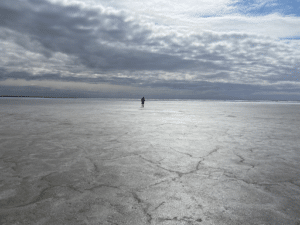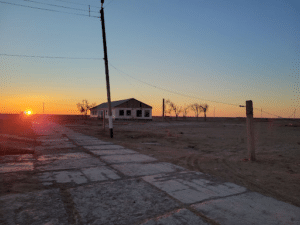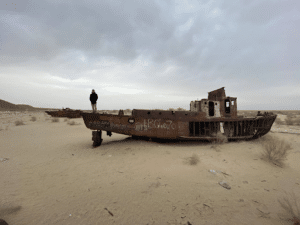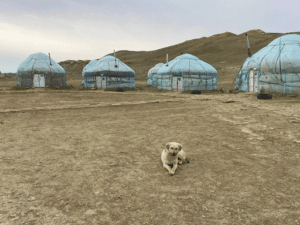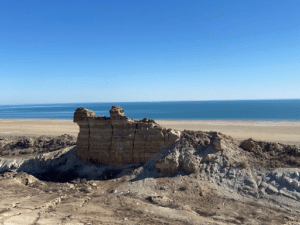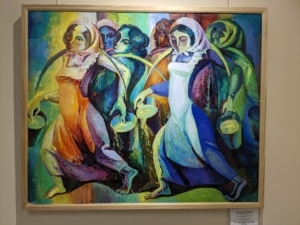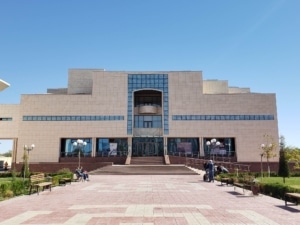When I first arrived in Nukus, the capital of the Autonomous Republic of Karakalpakstan, my immediate impression was that everything was salty. I mean this literally. As my friends and I exited the back seat of the taxi that had delivered us the three hours from Khiva, the first sensation I experienced was a distinct taste of salt in the frigid November air. It reminded me slightly of my home in Santa Cruz, California, only I’d never known the salt of the Pacific to permeate the air as strongly as the salt did in Nukus. On a later visit to the region, one of my friends even grew excited at one stop on a lonely and bleak highway, shouting out for us to look at all the “snow” on the ground. It was in fact just a field of salt.
Home of the Aral Sea catastrophe, and the historical homeland of the Karakalpaks, a unique people whose culture and language differs from the Uzbeks, Karakalpakstan’s harsh landscape inside Uzbekistan reflects its tumultuous history of subjugation, environmental degradation, and economic collapse.
During my year spent teaching English in the Ferghana Valley in eastern Uzbekistan, I was fortunate to be able to make three trips out to the Republic. While Karakalpakstan may initially appear to be nothing more than an obscure dot on the map of an already remote Central Asian nation, the land is packed full of culture and history, and is a powerful testament to the horrors and havoc that humans can wreak on even the most ancient and seemingly sturdy environments.
It’s been two years since I first stepped out of that taxi door, during which time I’ve moved back to California, pursued a Master’s degree, and began working as a program manager with SRAS. My role is to develop faculty-led programs in Central/Eastern Europe, the Caucasus, and Central Asia. While the Silk Road cities often steal the show when it comes to group tours in Uzbekistan, Karakalpakstan offers incredible opportunities for short term programs that will engage participants in issues regarding environmental and economic crises, ancient nomadic history, civil resistance and censorship in the Soviet Union, and ethnic and linguistic diversity within Central Asia.
So why spend time in Karakalpakstan? What is there to see and do? This article will shed light on the little-known Republic and capture what about this region makes it worth including in academic and cultural programs abroad.
The Aral Sea
The area was made famous by the Aral Sea crisis, which was caused, in short, by negligent Soviet governance and the mass production of water-depleting crops such as cotton, and students and scholars who are interested in the study of environmental catastrophes and man made climate change will find ample subject matter to explore here. Jumping off from the capital city of Nukus, groups have the opportunity to spend several days off-roading through the expansive Ustyurt Plateau to the Aral Sea shore.
There, they can stay in yurt camps, visit the abandoned fishing villages (a painful marker of the economic devastation caused by the crisis) and learn about the history of the sea and its lasting impact on the region. Expert guides and local environmentalists take these groups through multiple sites leading up to the actual sea. Participants will not only learn about the territory’s ecological history, but the people who inhabited the plateau and fished the sea and farmed the land for centuries.
It was on a tour like this that my friends and I encountered those salt fields, a powerful scene reminding us that the consequences of this disaster are far reaching and invasive. Excess salt deposits that scattered to the wind as the sea dried are just one of the many harmful toxins that poison the air and water in Karakalpakstan. The Aral Sea is a reminder that as remote, wild and removed Karakalpakstan may seem from the U.S., we are at risk of similar catastrophes and climate issues in our own country. California’s Salton Sea crisis, for example, is not so different from the tragedy of the Aral Sea, as is Utah’s Great Salt Lake crisis.
While many might focus on only the sea and “disaster tourism,” Karakalpakstan is a nation with an ancient and rich culture that also deserves to be explored. Today, Karakalpaks want to be known for more than their worst tragedy. Environmental issues are an important reason for visiting the Republic, but certainly not the only reason.
Culture and History
Compared to the manicured cities of Khiva, Bukhara, and Samarkand, all of which mesmerize visitors with their ornate Islamic architecture, Karakalpakstan feels a world away – a remote corner on the fringe of a once powerful colonial empire, now struggling for economic prosperity, healthy living standards, and fair political representation. However, the Republic has no shortage of fascinating cultural sites and experiences.
Drive 20 minutes outside of Nukus and you will encounter the great Mizdakahn Necropolis, an ancient Zoroastrian settlement dating to the 4th century B.C.. Mizdakhan tells a rich and complex history of the people that once inhabited the land, as well as its current occupants. The necropolis is not only an ancient archaeological site, but is also an active cemetery, with local families continuing to bury their loved ones wherever they can find a plot. The presence of contemporary graves in what would otherwise be the ruins of a civilization lost to time, beautifully weave together ancient and modern Karakalpak stories.
Meanwhile, in downtown Nukus, one can spend hours exploring the legendary Savitsky Museum, which houses one of the most impressive collections of avant-garde art in the world. Its founder, Muscovite Igor Savitsky, specifically chose Nukus as the perfect secluded site to smuggle banned art from all over the Soviet Union. It is thanks to his courage and defiance, as well as the remote and seemingly forsaken territory of Karakalpakstan, that hundreds of voices and stories, especially those from Central Asia, can be told today. The museum stands as a testament to Savitsky’s legacy: defending artistic expression in the Soviet Union, and championing narratives that the government attempted to suppress. It seems fitting then that the museum is located in Karakalpakstan, a republic that continuously fights to have its voice heard.
Karakalpak culture is as ancient as it is fascinating.
Why Spend Time in Karakalpakstan?
Adventurous travelers should be attracted to Karakalpakstan, where short programs can showcase the deep cultural and linguistic diversity that exists in Central Asia. Unlike the rest of the nation, you will not hear Uzbek or Tajik widely spoken in Nukus. Instead, Karakalpak and Russian are the official languages used in the government and in schools. On the streets, students will find it easy to engage with locals in Russian, thus making it a good destination for language students to practice in a real-world context. Travel to Karakalpakstan also allows students to engage with a culture and community that is continuously disregarded and overlooked. As educators seek to recenter and redefine our perceptions of the Russian-speaking world, it is critical that we send students to these remote regions and pay them the attention, respect and curiosity that we do to other Russophone areas.
Karakalpak history and culture starkly differs from that wider Uzbekistan’s. Not only does Karakalpak belong to an entirely different branch of the Turkic language family than Uzbek, their ancestral roots are more closely tied to Kazakh nomadic tribes than Uzbek settlements. Karakalpaks, unlike Uzbeks, were fully nomadic for many centuries, and this is reflected today in their fiercely independent spirit. A perfect example of Karakalpak independence is the legend of Qyrq Qyz, or the Forty Girls. This ancient oral epic tells of the teenage warrior Gulaim, who bands together with forty women warriors to defend her home on the Aral Sea from invaders. The story predates the arrival of Islam in Central Asia, and despite many attempts to suppress the tale in a male dominated culture, has remained a powerful narrative, one that speaks to the fighting spirit of the Karakalpaks, and their complex ideas around gender roles, identity, and tribal loyalty. Today, Qyrq Qyz is performed on stage as a musical ballad, using traditional instruments such as the dutar and the Karakalpak jaw harp, as well as throat singing, an ode to Karakalpakstan’s distinct musical traditions. While Karakalpakstan, like most of the world, still faces issues of gender inequality, it was easy to see some stark differences between Karakalpak and Uzbek culture when it came to gender roles and male – female interactions. I will never forget being shocked to see boys and girls, around age 11 or 12, playing soccer in a courtyard together, without any backlash. In the Fergana Valley, for example, most girls were not even allowed to play soccer (due to traditional Islamic stigma against women exercising in public), let alone play it with boys. It was little moments like this that constantly reinforced Karakalpakstan’s unique societal values and ways of life for me.
Lastly, programs to Karakalpakstan provide an invaluable opportunity to observe and study one of the worst man made environmental disasters of the 20th century. As environmental issues and catastrophes continue to grow in scope and scale, climate change is an increasingly critical field of study. Karakalpakstan offers an incredible opportunity for adventurous students and scholars to engage with the impact of these issues firsthand in one of the world’s most outlying, yet fascinating territories.


